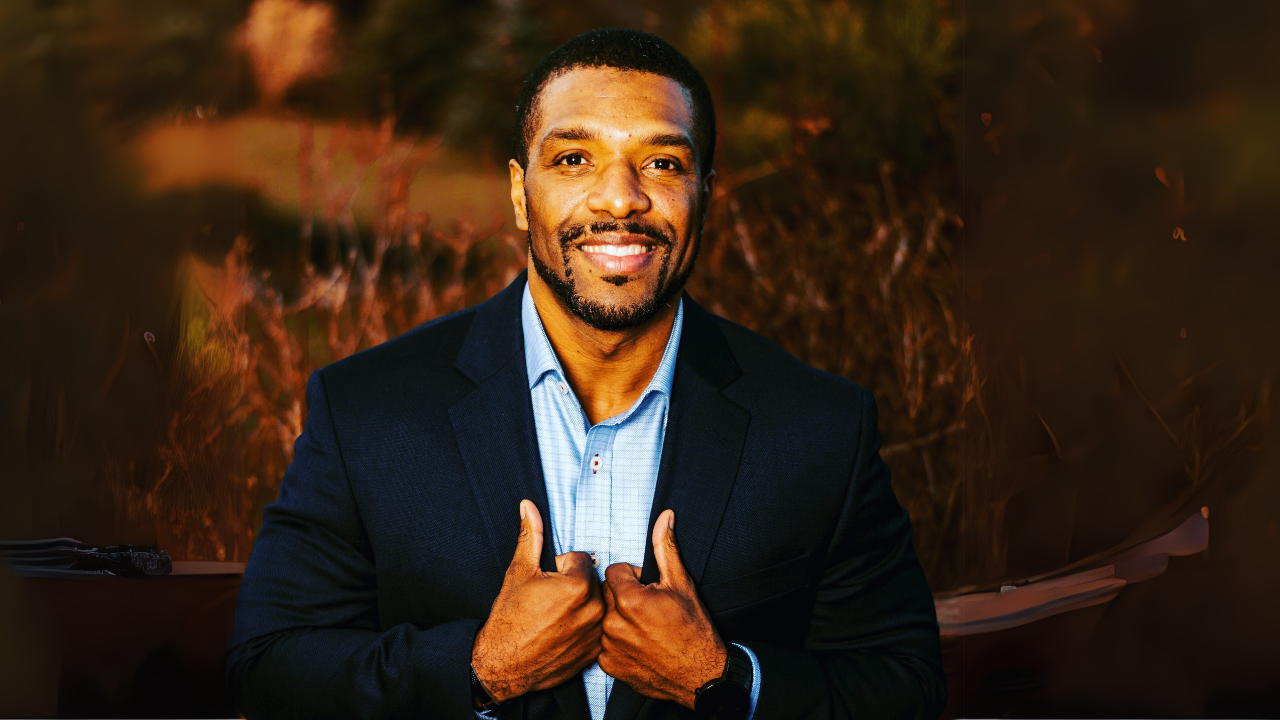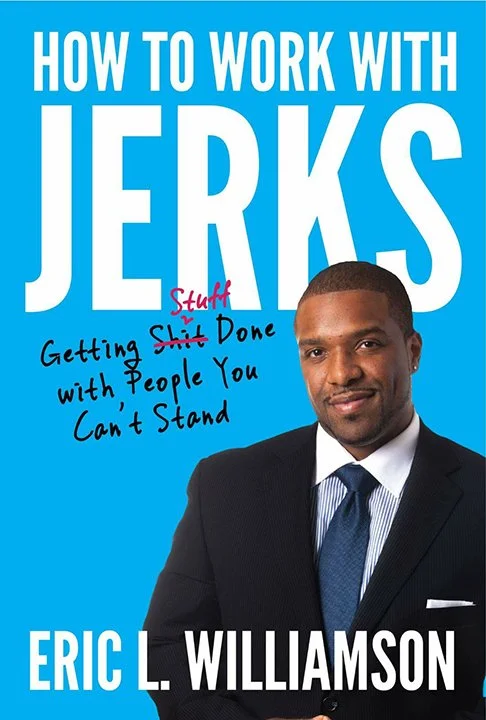Navigating Jerks Without Losing Yourself: A Conversation with Eric Williamson
Some people spend their whole careers avoiding conflict. Eric Williamson built his life’s work helping people face it—without turning into jerks (or losing their sanity) along the way.
His book, How to Work with Jerks, hit home for me in a way few leadership books do. It’s one of those reads that makes you reflect not just on the people around you—but on how you show up, too.
When I invited Eric to share his story with the Tech She Secures tribe, he immediately said yes—and brought incredible candor, wisdom, and generosity to this conversation.
What followed was one of the most thoughtful leadership conversations I’ve had the privilege to be part of—and one that left me with more than a few “aha” moments.
Eric’s work is grounded in emotional intelligence, clear communication, and helping create workplaces where candor and compassion actually coexist (yes, it’s possible). In this conversation, he shares not only lessons from his own leadership journey, but practical tools we can all use—to navigate conflict, to reclaim our voice, to set boundaries, and to lead with more intention and heart. Especially in spaces where that’s easier said than done.
I’m grateful for this connection—and honored to share Eric’s voice and story with all of you.
Career Journey & Origins
What’s your origin story? What shaped your early views on leadership and conflict—and how did those experiences lead you to the work you do today?
Early in my career, I didn’t handle conflict well—like a lot of people, honestly. I either avoided it altogether or bulldozed right through it. I thought being direct automatically meant being effective.
But I quickly realized that while I was getting results, I was also leaving damaged relationships behind. People felt drained or frustrated after working with me. It wasn’t until I was almost fired from a job that I had to really face that. I had become that guy—someone who delivered, but at what cost?
That experience—along with the support of some incredible mentors—forced me to rethink what leadership really looks like. It pushed me into a deeper journey of growth, where I started to explore emotional intelligence and communication. That path ultimately led me to the work I do now: helping people navigate conflict without becoming jerks in the process.
Speaking of Jerks, you’ve described yourself as a “jerk expert.” What was the turning point that made you want to rewrite that narrative—for yourself and for others—and eventually write your amazing book, How to Work with Jerks, which I honestly can’t stop recommending?
I’m glad the book has resonated with you. It was definitely written for the kinds of situations we’ve talked about—and the ones so many people find themselves in.
The turning point for me was realizing that I was the jerk in the story. I was passionate, driven… but emotionally unaware. People let me know—sometimes directly, sometimes not so directly—and it really forced me to grow.
That realization led me to dive into studying conflict, behavior, and emotional intelligence. And as I learned more, I saw how a lack of self-awareness was at the root of so many issues—not just for me, but for others, too. I wrote How to Work with Jerks because I kept seeing people struggle with the same thing. So many of us are taught that academic success will naturally translate into professional success—but no one really teaches us how to handle difficult people, or how to manage our emotions in high-stress situations.
Without tools to protect their peace and stay productive, people end up burnt out or stuck. The book was my way of offering those tools—and maybe adding a little humor along the way—so people don’t just survive the jerks in their lives… they grow stronger because of them.
Tell us about the 'BADdest' challenge you’ve taken on in your career—the boldest, most authentic, and driven moment you’re most proud of—and how it shaped who you are today.
First of all—I love that! That is a badass acronym.
So, I’d say this: leaving my comfort zone to build my speaking and coaching business—while still working full-time—that was probably one of the boldest decisions I’ve ever made.
It forced me to juggle two worlds, but it also meant betting on myself instead of doing what everyone else saw as success—climbing the corporate ladder. That just wasn’t me.
Rather than fulfilling someone else’s version of success, I wanted to chase my own goals and dreams. I wanted to use my voice in spaces where it wasn’t always expected.
That moment—when I stopped waiting for permission and started moving with purpose—that changed everything for me.
It taught me that when your message is rooted in impact, not ego—and mine was—that’s when people really listen. And more importantly, that’s when they start to change.
So yeah, that was definitely the BADdest move I’ve made. And I’m proud of it.
Emotional Intelligence & Navigating Conflict
What’s one common myth about dealing with difficult people (aka “jerks”) that you’d love to debunk?
The biggest myth I hear is that the only way to deal with conflict is to avoid it. And in reality? You really shouldn’t be avoiding conflict at all—unless your safety is at risk. If there’s a chance of bodily harm, that’s a different story. But most of the time, avoiding conflict just makes things worse.
You don’t have to shrink yourself to make other people comfortable. If you can assess the situation, understand the emotional drivers behind it, and respond in a way that protects your peace and preserves your power—you can face it head-on.
A lot of people still think emotional intelligence and conflict resolution are “soft skills.” But I see them as superpowers—they are power skills. Being able to navigate tough situations with clarity and empathy? That’s real strength.
So yeah, avoiding conflict might feel easier in the moment, but it doesn’t solve anything. That’s why I’m all about equipping people with specific conflict skills—so they can deal with it directly, and do it well.
What are some early signs that someone may be stuck in a toxic work dynamic—and what should they do when they notice them?
I think one of the first signs is when people start second-guessing themselves—how they respond, how they show up. If you’re constantly thinking, “I don’t want to ruffle any feathers,” or “I need to walk on eggshells,” because you're afraid of how someone might react… that’s a sign.
When you start adjusting your behavior to avoid upsetting others, it’s usually a signal that the environment you’re in doesn’t feel safe. And when you don’t feel safe, you can’t bring your full self to work. You end up spending all your energy trying to appease others.
I always say: toxicity thrives in silence. If your energy is leaking, if you’re drained from constantly trying to manage someone else’s emotions, that’s your cue to pause. Reflect. Set some emotional boundaries. Because if you don’t, it’s only a matter of time before it starts affecting your personal life too.
Talk to someone. That could be a coach, a mentor, even a therapist. Get support and build a strategy to regain control. That’s what I work on with a lot of folks in my coaching—helping them reclaim their peace and power in workplaces that have worn them down.
In high-pressure moments—especially when you feel disrespected or dismissed—how do you center yourself and respond with intention?
I have this three-step process I talk about a lot in my trainings and coaching. It’s called the AAA Method—Assess, Analyze, Act. I wanted to keep it simple and easy to remember, especially in the heat of the moment.
When you’re in those high-pressure situations—when you feel dismissed, disrespected—you might feel the urge to snap back and tell the person off. Or maybe you shut down completely. Either way, you’re reacting, not responding with intention. That’s where this method comes in.
Step one is Assess. What just happened? What is your body telling you? Our bodies give us signals all the time—tight shoulders, clenched jaw, red face—those are signs you’re under stress. Recognize it.
Step two is Analyze. Why is your body reacting like that? What’s the real trigger? What’s underneath the surface of what was said or done?
And then step three is Act—but not in the heat of the moment. Breathe. Respond in a way that reflects your values, not your anger.
Before I practiced this, I used to jump straight to step three—and I’d say the first thing that came to mind. And let me tell you, I made bad situations even worse.
This method isn’t some revolutionary idea—it’s really about being more intentional. Even Starbucks has a version called the LATTE method for dealing with upset customers. Same principle. It’s about slowing down, staying grounded, and giving yourself permission to pause before you respond.
Because here’s the truth: we don’t have to react right away. Giving yourself that space can make all the difference.
Leadership, Mentorship & Real Talk
You mentor leaders across industries. What’s one piece of advice you find yourself giving again and again?
There’s plenty. But off the top of my head, I’d say this: leadership starts with self-awareness.
Some people know they’re acting like a jerk—they just think it’s the most effective way to get things done. But then there are others who have no idea how their behavior is impacting those around them.
You can’t lead others well if you don’t understand yourself first—your triggers, your blind spots, your values. Emotional intelligence, like I’ve mentioned before, is the foundation. It’s not just a nice-to-have—it’s a necessity.
It’s how you build influence. It’s how you stay grounded under pressure. And it’s how you build real relationships. Because at the end of the day, if you don’t know who you are or how you’re showing up, it’s going to be hard to lead anyone else with intention.
How can professionals—especially those from underrepresented backgrounds—set boundaries or advocate for themselves without being labeled “difficult” or “too emotional”?
You know… let’s be real. The bias is unfair—but it exists.
Professionals from underrepresented backgrounds are often labeled or misunderstood simply because they come from a different place, carry a different experience, or tell a different story.
Here’s what I always say: clarity is your best friend.
Know your value. Understand what you bring to the table. Document your wins. Communicate with confidence. And share your story—without apology.
Ask for what you need. Lead with facts. Focus on data, not drama. Don’t feed into the noise.
Because when someone tries to label you just for setting a boundary, that says more about them than it does about you.
You’re not being difficult—you’re being decisive.
It’s just a shame, honestly, that people can make us feel like we’re the problem… when that’s not always the case.
For the Tech She Secures Tribe
Many women and underrepresented professionals in tech, cybersecurity, and beyond silently carry the weight of workplace tension while still trying to lead and deliver. What would you say to someone who feels stuck, unseen, or undervalued?
I’d start by saying: you’re not alone. And it’s not just in your head. That tension you feel, it’s real. But here’s the thing—you’re not powerless either.
Start by reconnecting with your why. Your value isn’t based on who notices—it’s based on what you bring to the table.
Build your circle. That could be a mentor, a coach, or a community—like Tech She Secures. Surround yourself with people who remind you of your brilliance until you start believing it again.
Because you don’t have to do this in silence. And you don’t have to do it alone.
There are spaces—like the one you’ve built, and others out there—where people can find the support they need.
What’s one mindset shift or small practice that can help someone reclaim their energy, confidence, or voice—even in difficult environments?
This is something I actually learned recently, during a good conversation at a speaking event.
I’d start by asking: What do I own today? Not what do I owe or what don’t I have—but what do I get to own?
If you want to reclaim your energy and confidence, start with that. What do I get to own? What do I have accountability over?
It’s your voice. Your values. Your vision.
All of that still matters—even in difficult environments. And we should hold onto that—and live that purpose.
Meaning of Success and Looking Ahead
What does success mean to you now—especially after working through conflict and building something of your own?
It goes back to when I decided to build my business.
When I was in the corporate world, it was always, “You should apply for this promotion,” or “You need to act a certain way to stand out and be the obvious choice.” People would say, “Don’t you want this?” And honestly, inside, my answer was always, “No. I don’t want to do that at all.” It didn’t inspire me. I didn’t enjoy it.
It wasn’t until I started leaning into and embracing what I really wanted that things started to align. That’s when I began asking myself the real questions:
Am I using my gifts to make a difference?
Am I present with my family?
Am I being true to myself—even when it’s hard?
Am I living my values and continuing to grow?
To me, that’s what success looks like.
It’s not about climbing the corporate ladder. It’s not about making a ton of money. It’s about this:
Am I being a good father? A good husband? A good person? Am I helping others?
Everything else will come. But if I can answer yes to those things… that’s all I really need to feel successful.
What’s your vision for a healthier, more emotionally intelligent workplace—and what gives you hope about how leadership is evolving?
Well, I would say—and this is something I go into more in my next book that’s coming out soon, The Jerk-Free Workplace: Building Bridges, Resolving Conflict, and Fostering Collaboration—it’s about creating a jerk-free workplace.
My vision for a healthier, emotionally intelligent workplace is one where people can work jerk-free. Where we stand up to jerks in the workplace, and we don’t tolerate that kind of behavior. Because when that happens, people are able to add value, to contribute in a way that’s actually effective.
It’s about environments where candor and compassion coexist. Where people feel safe enough to speak up—but also strong enough to listen.
And I’m hopeful because I see more leaders stepping into that. I coach a lot of leaders—especially in IT—who are asking the hard questions. They’re not just measuring performance anymore. They’re measuring people.
And to me, that’s where real transformation starts.
Closing Reflections
"You’re not being difficult—you’re being decisive."
That line—one of many that stayed with me from this conversation—is one I know I’ll carry forward.
What I appreciate most is that Eric didn’t just talk about leadership—he modeled it. With honesty, humility, and the kind of real-world wisdom we all need more of in today’s workplaces.
Throughout this interview, and in all of his work, Eric reminds us that leadership isn’t about being the loudest in the room. It’s about showing up with clarity, intention, and courage—and creating space where others can do the same.
I’m so grateful Eric shared his story with the Tech She Secures community. I can’t wait to keep learning from his work—and to follow the impact he continues to make on how we think about emotional intelligence, workplace culture, and building healthier, jerk-free workplaces.
Maliha
Disclaimer: The content on this blog and website reflects a combination of my personal experiences, perspectives, and insights, as well as interviews and contributions from other individuals. It does not represent the opinions, policies, or strategies of any organization I am currently affiliated with or have been affiliated with in the past. This platform serves as a personal space for sharing ideas, lessons learned, and meaningful reflections.



